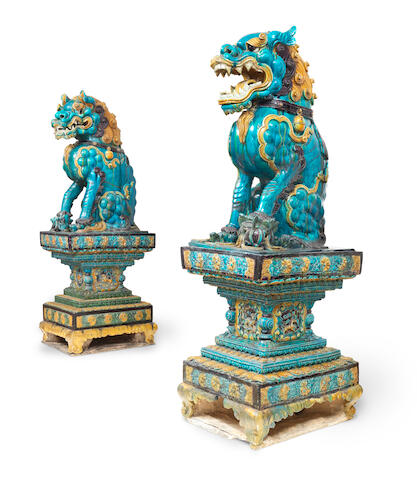 03-06-2024, 01:12 PM
03-06-2024, 01:12 PM
|
#22260
|
|
Member
How Do You Identify?:
As a very feminine woman.
Relationship Status:
Busy dating a special someone here at home
Join Date: May 2010
Location: In a small community
Posts: 16,262
Thanks: 29,369
Thanked 33,631 Times in 10,723 Posts
Rep Power: 21474868
|
 Buddhist Chinthe Lions | *** Om ***
Buddhist Chinthe Lions | *** Om ***
 A very rare pair of monumental fahua Buddhist lions on stands
A very rare pair of monumental fahua Buddhist lions on stands
Late Ming Dynasty, 16th/17th century
From Bonham's website:
Quote:
This pair has survived remarkably well and each assembly is presented imposingly in three parts with the lion resting on a matching two-piece pedestal 90 cm (36 in) high. They announce in many ways their Buddhist association.
The male lion, traditionally positioned on the right as one faces the hall, sits open-mouthed and staring ahead with his left front paw, as is customary, resting playfully on an embroidered brocade ball. The female sits to the left with her mouth nearly shut and, as is also customary, has her right paw clasped protectively around her cub. The ball and cub are strongly embedded in traditional styling, and explanations for their meaning are offered in the folklore of different East Asian countries. However, their origin and true significance are now obscure.
Similarly, the 'one mouth shut and one open' convention is seen often in guardian figure pairs, and explanations are offered throughout Asia for its significance. Many agree that 'mouth open' signifies vocalisation of the first character, 'a', of the Sanskrit alphabet, and 'mouth shut' the last, 'um', and that together they represent the sound 'om' which expresses the 'Absolute or Ultimate Reality' in the Sanskrit mantra. Another interpretation is that the two sounds represent the 'first and last breath' or the beginning and end of life whilst, in some Japanese traditions, a third suggests in a similar vein that the male lion inhales whilst the lioness exhales, symbolising 'life and death'.
More compelling are the astonishing eyes of the lioness. Whilst her right eye stares fixedly ahead, her left eye is swivelled rearwards as if re-directing her gaze towards, or to some point behind, her mate. This strabismus is clearly intended but its meaning is unclear. Moreover, the skilful modelling of the animal's head and facial contours renders this intriguing and unusual feature almost unnoticeable at first sight to the casual frontal observer.
Remarkable also is the tightly coiled 'coiffure' of the lions' manes which refers strongly to the archaic influence of Greco-Buddhist art from Central Asia in the early days of Buddhism in China in the 5th century.
|
To read more about Chinthe Buddhist Lions ( LINK)
__________________
“The way someone treats you is not a reflection of your worth: It’s a reflection of their emotional capacity,”
— Jillian Turecki.
”Without justice, democracy dies,”
— Jess Michaels (Epstein survivor).
|

|

|